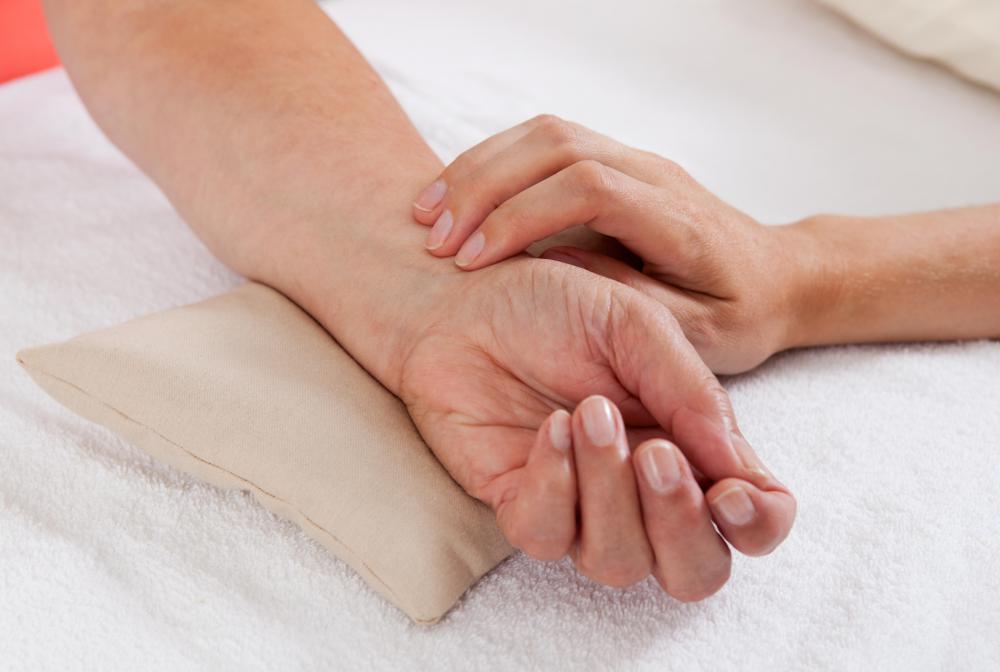At WiseGEEK, we're committed to delivering accurate, trustworthy information. Our expert-authored content is rigorously fact-checked and sourced from credible authorities. Discover how we uphold the highest standards in providing you with reliable knowledge.
What Are the Pros and Cons of Using Hypothermia after Cardiac Arrest?
Hypothermia after cardiac arrest cools the body, decreasing the brain’s demand for oxygen. The use of this treatment has significantly improved the subsequent brain functioning of patients who have been revived after cardiac arrest, and has reduced mortality rates. Without the treatment, the brain is deprived of oxygen and suffers damage. This therapy is not recommended for all cardiac arrest patients. Increased risk is involved for patients who also have a head injury, those already in a coma, patients who are bleeding and others.
In addition to improving neurological functioning and increasing survival rates, hypothermia after cardiac arrest is a cost-effective treatment option. One major disadvantage to cardiac patients is that the therapy is not in widespread use. Many hospitals and physicians do not employ induced hypothermia, but it is gaining in acceptance and use. Successful programs require all facets of the medical team, from emergency medical technicians to intensive care staff, to be coordinated in the use of hypothermia for cardiac arrest. Another disadvantage is that it is not an appropriate treatment for all who suffer cardiac arrest.

Patients who experience sudden cardiac arrest may have their heartbeat restarted but fail to quickly regain consciousness. This is because the blood supply during and after cardiac arrest has been insufficient for the brain to function properly. Medical research has found that lowering the body temperature to between 89 to 93 ° Fahrenheit (32-34 ° C) reduces the brain’s demand for oxygen. The cooling is done quickly, and the patient is kept in an induced hypothermic coma for up to 24 hours. This allows the organs and brain to recover more fully than if the patient were at normal temperatures.

One study compared the results of patients who underwent therapeutic hypothermia after cardiac arrest with patients who did not. After six months, three areas of concern — brain performance, mortality and complication rates — were compared for the two groups. There was a significant positive difference in brain function in the hypothermia group and a decrease in mortality rates. Complication rates were not significantly different between the two groups.

The technology has shown significant benefits, and many physicians and researchers believe it is unethical to continue studies that deny one group of patients therapeutic hypothermia. Hospitals that use the technology are seeing a compelling difference in brain function after sudden cardiac arrest. Before using therapeutic hypothermia after cardiac arrest, only a small percentage of patients recovered full or acceptable brain function. With the treatment, an estimated half of cardiac arrest patients do.
AS FEATURED ON:
AS FEATURED ON:













Discussion Comments
@clintflint - Honestly, I'm surprised we aren't further along with this kind of technology. Science has been aware of the preserving effects of freezing someone for generations and miracles have occurred when people have drowned in ice water and been revived hours later without any lingering effects.
I know people associate this with a kind of stasis but it could be used more often for short term aid in a lot of cases.
@bythewell - I have heard that they are starting to figure out ways for ambulances to carry devices that will induce hypothermia on route to the hospital, and it's definitely being done by some ambulance services.
I believe they don't try to cool down every part of the body, but just focus on the brain and maybe other vital organs. The brain is the most important part though, as it will start to die very quickly when deprived of oxygen. Cooling it down even a little can help to delay this process.
With the right kinds of equipment it's actually not that necessary to have fully qualified doctors to make this kind of decision on hand. A qualified EMT can do it just as well.
I think one of the reasons this is not more widely employed is because often cardiac arrest happens when a patient isn't in a hospital setting and the emergency teams that are called by ambulance aren't equipped to do the procedure.
Properly done induced hypothermia is quite tricky and requires a lot of experts on hand as well as sophisticated equipment. It's not a matter of just throwing some ice on a person and hoping for the best.
Post your comments